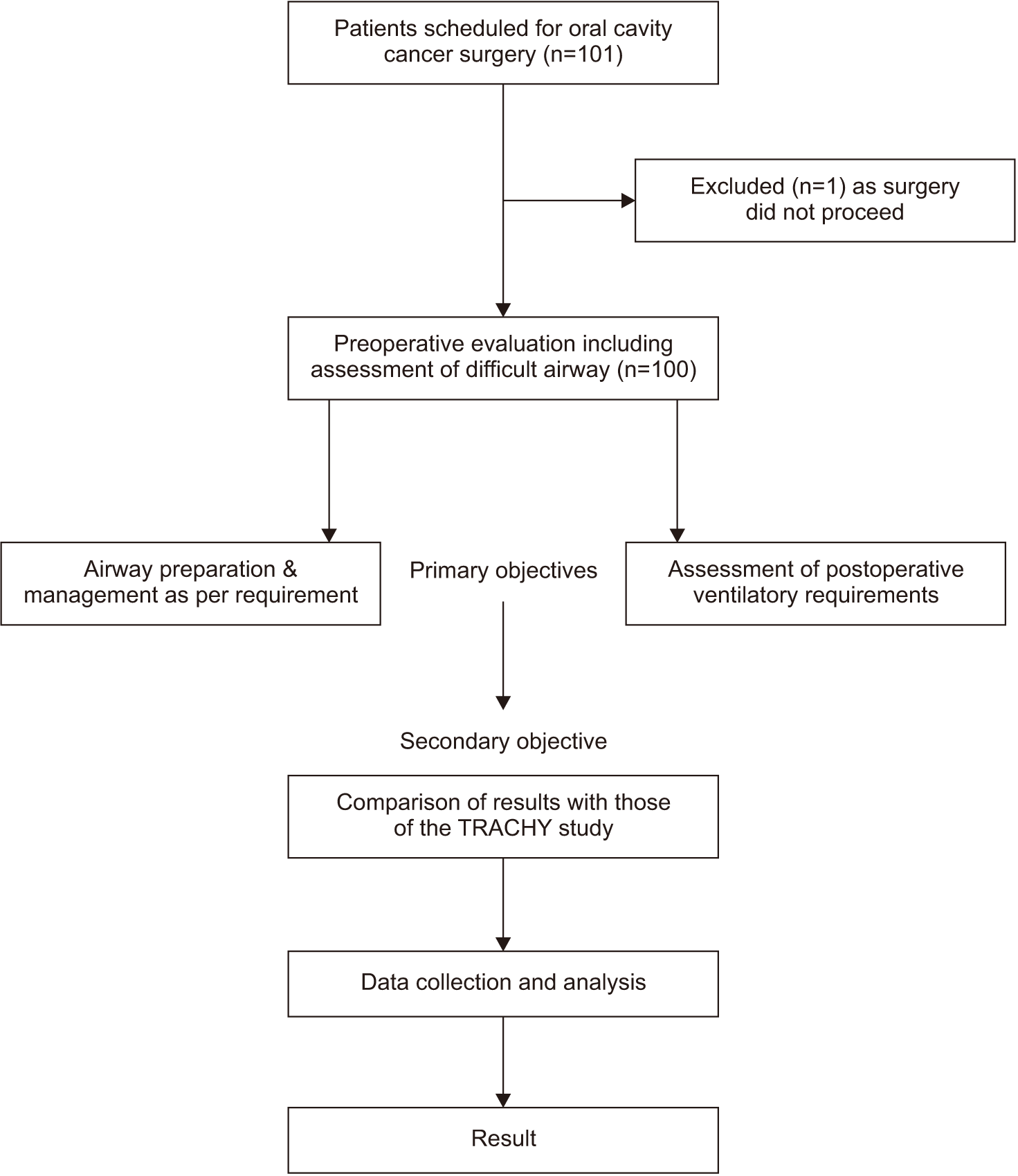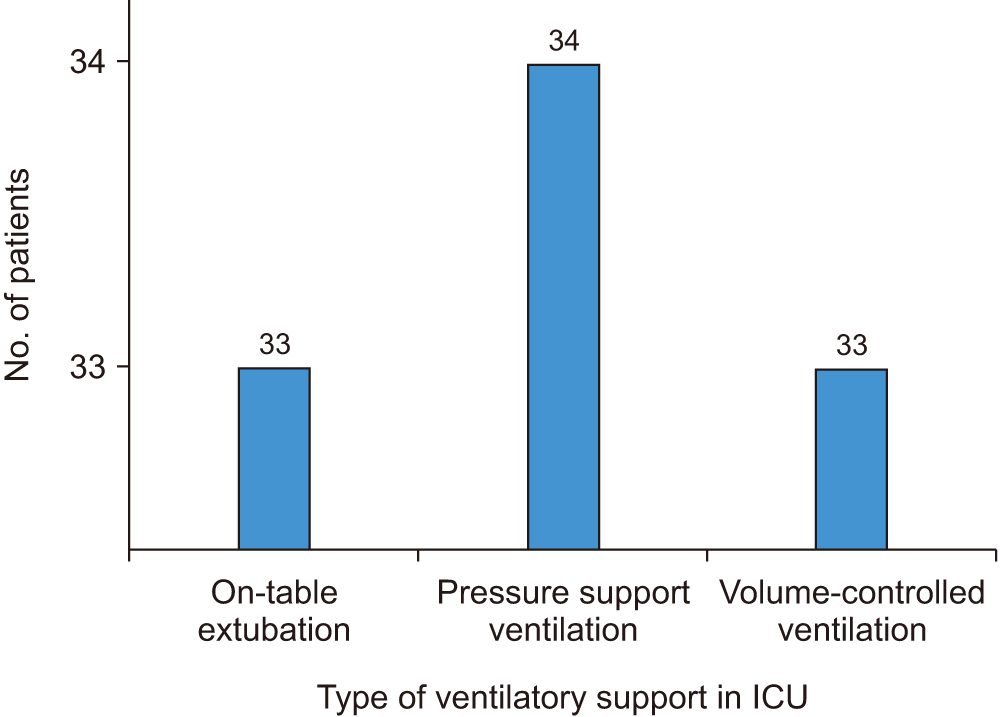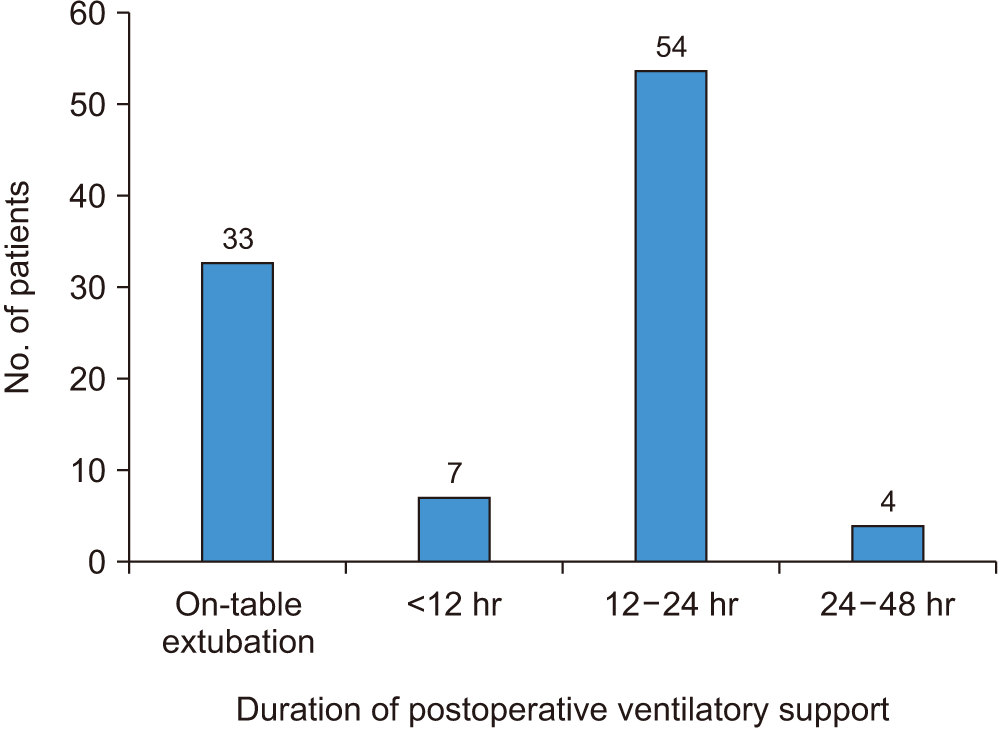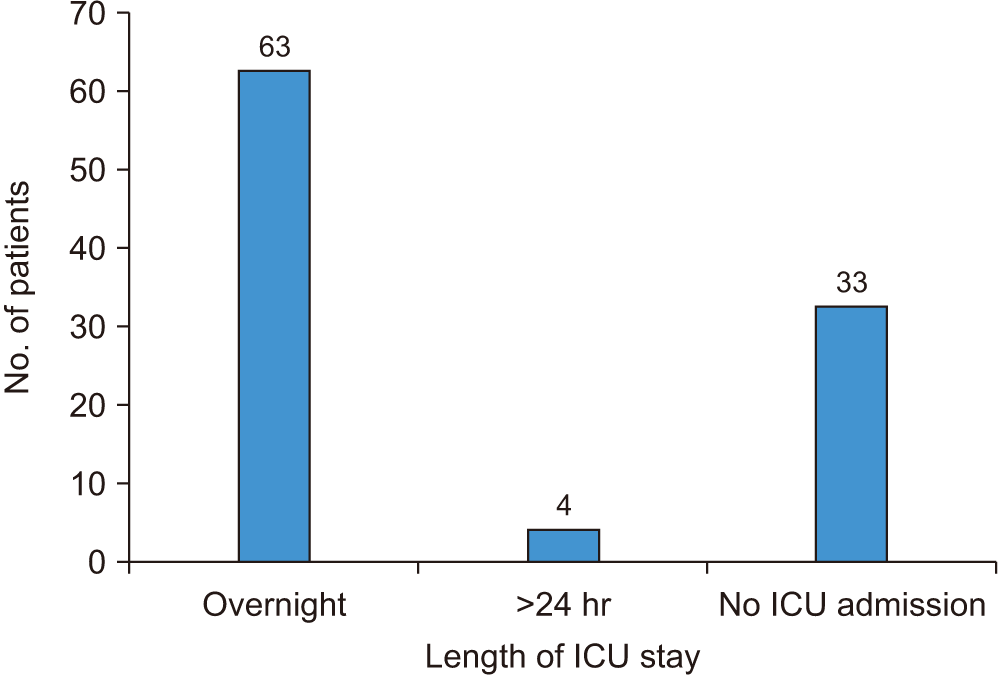Abstract
Objectives
This prospective observational study aimed to assess the clinical outcomes of perioperative airway and ventilatory management in patients undergoing surgery for oral cavity cancer. The study described the frequencies and types of procedures for securing the airway and the duration and types of postoperative ventilatory support. We compared the findings with those of the TRACHY study.
Patients and Methods One hundred patients undergoing oral cavity oncological surgeries were included. Airway assessment included inter-incisor gap, Mallampati class, neck movements, and radiological features. Surgical parameters, postoperative ventilatory support, and complications were documented.
Results
The buccal mucosa was the most common cancer site (48.0%), and direct laryngoscopy was deemed difficult in 58.0% of patients. Awake fibreoptic intubation or elective tracheostomy was required in 43.0% of cases. Thirty-three patients were extubated on the table, and 34 patients were successfully managed with a delayed extubation strategy. In comparison with the TRACHY study, variations were observed in demographic parameters, tumour characteristics, and surgical interventions. Our mean TRACHY score was 1.38, and only five patients had a score ≥4. Prophylactic tracheostomy was performed in 2.0% of cases, in contrast to the TRACHY study in which 42.0% of patients underwent the procedure.
Conclusion
The study emphasizes the challenges in airway management for oral cavity cancer surgery. While prophylactic tracheostomy may be necessary in specific cases, individualized approaches, including delayed extubation, are preferrable to maximize safety. Our findings contribute to better understanding and managing perioperative challenges in oral cancer patients and highlight the need for personalized strategies. Scoring systems like TRACHY should not be accepted as universally applicable.
Oral cavity cancer includes tumours of heterogeneous pathologies and may originate from diverse sites such as the lip, floor of the mouth, tongue, alveolar ridge, retromolar gingiva, hard palate, and buccal mucosa. Its global incidence among malignancies is notably high, and nearly 30% of newly detected malignancies in India are attributable to oral cancers that are primarily linked to widespread tobacco use1.
For loco-regionally advanced cases, surgery is the preferred initial treatment modality. However, surgery presents challenges to anaesthesiologists due to the potential for a “difficult airway”2,3. Difficulties stem from tumour-induced distortion of upper airway anatomy, reduced inter-incisor gap, and soft tissue fixation due to surgical scarring or fibrosis. Radiation therapy further limits mouth opening and neck movements due to fibrosis of muscles.
Additional concerns include shared airway issues, prolonged surgeries, and postoperative airway oedema. Surgical resection may or may not involve immediate reconstruction4. Airway and ventilatory management following reconstruction are critical due to potential compromises from a bulky flap, flap or airway oedema, and hematoma formation5. Procedures like bilateral neck dissections or resections of the mandible, tongue, and floor of the mouth pose the greatest risk of airway compromise. The potential complications are severe and include acute asphyxia, brain damage, and death. This emphasizes the paramount importance of safe postoperative airway management6-8.
Traditionally, prophylactic tracheostomy was utilized post-surgery; however, high complication rates, ranging from 4% to 45%, have prompted reconsideration of this practice4,5,9. Enhanced recovery after surgery programs advocate selective tracheostomy use, and newer trends support delayed extubation in the intensive care unit (ICU) to mitigate airway oedema and prevent complications10.
The optimal method for perioperative airway and ventilatory management remains controversial, and decisions on elective tracheostomy are usually contingent on benefit-to-risk ratios. Various scoring systems, including the TRACHY score developed by Mohamedbhai et al.11 and the elective tracheostomy scoring system developed by Kim et al.12, have been developed to predict the need for elective tracheostomy in oral cancer surgery patients. However, a comprehensive and objective evaluation index is lacking.
This prospective observational study aimed to describe the frequency and types of procedures for establishing a secure airway, along with the duration and types of postoperative ventilatory support in patients undergoing oral cancer surgery. A comparison with the TRACHY study was conducted, enhancing our ability to evaluate and manage oral tumour surgery patients and predict perioperative outcomes. The study addresses the need for better understanding and management of perioperative challenges in oral cancer patients, contributing valuable insights to optimize patient care.
The study was conducted at the All India Institute of Medical Sciences, Bhopal, a tertiary referral teaching hospital in Bhopal, India. Ethical approval for this study was provided by the Institutional Ethics Committee of All India Institute of Medical Sciences, Bhopal (No. IHEC-PGR/2021/DM/M.CcH/Jan/09). This was a prospective observational study including consecutive adult oral cancer surgery patients from September 2021 to December 2022. Written informed consent was obtained from the patients, who were followed from the time of surgery until discharge from the post anaesthesia care unit (PACU) or ICU.
We included patients who were 18-80 years of age and undergoing elective major oral cancer surgery for the first time. Patients undergoing surgery of the maxilla were not included.
A thorough pre-anaesthesia examination was performed in all patients, with special emphasis on examination of the airway. Radiological features of difficult airway, tumour stage, anatomical position of the tumour, and history of previous surgery/radiotherapy were also noted.
Airway preparation was undertaken on the day of surgery, and the measures performed met individual case requirements. A decision on elective tracheostomy was made in conjunction with consultation with the surgeon. General anaesthesia was administered as per standard protocol.
Parameters assessed in the intraoperative period were duration of surgery, laterality of neck dissection, type of reconstruction performed, and need for vasopressors.
At the end of the surgery, a decision on the need for overnight ICU stay with an endotracheal tube in situ was made in cases of bilateral surgery, myocutaneous or composite flap reconstruction, hypothermia, haemodynamic instability, abnormal blood gas levels, or anticipation of airway oedema.
In the postoperative period, the time of extubation, need for emergency tracheostomy, and length of ICU stay were noted.
Patient assessment and data collection were performed in the intraoperative and postoperative periods until entry into the PACU or ICU.(Fig. 1)
Statistical analysis was performed using the IBM SPSS Statistics program for Windows (ver. 26; IBM Corp.). Continuous variables are presented as mean±standard deviation. Data with a skewed distribution are described as median (interquartile range), and categorical variables are presented as absolute number and percentage. The associations between nominal or categorical attributes were assessed using chi-square/Fisher’s exact test. For all statistical tests, a P-value less than 0.05 indicated a significant difference.
A total of 101 patients were enrolled, one of whom subsequently was excluded due to surgery non-performance.
The largest number of patients was in the 41- to 50-year age group, and the mean age of the study population was 48.0±11.7 years. The majority (76.0%) of cases was male.
In our study, the buccal mucosa was the most common tumour site (48.0%), followed by the tongue (29.0%), alveolus (20.0%), floor of the mouth (2.0%), and lip (1.0%).
The mean TRACHY score in our study was 1.38. Only five patients had a TRACHY score ≥4. Surgeries for patients with score ≥4 included composite resection of bilateral tongue carcinoma (score 6); composite resection and reconstruction of recurrent left buccal mucosal carcinoma post radiotherapy (score 6); composite resection and reconstruction of tongue carcinoma (score 4); hemi-glossectomy, floor of mouth excision, segmental mandibulectomy, and reconstruction of malignant melanoma involving floor of the mouth and tongue (score 7); and composite resection and reconstruction of carcinoma involving the lower lip (score 5).
Compared to the TRACHY study, although the number of patients with tumour stage grading was similar, the number of patients with American Society of Anesthesiologists (ASA) 3 classification, previous surgery/radiotherapy, anterior/oropharyngeal tumour, or bilateral surgery was significantly smaller in our study.(Table 1)
An inter-incisor gap ≥3 cm, present in 58.0% of our patients, was considered adequate for direct laryngoscopy. The largest number of patients (42.0%) was in the Mallampati class IV group. An inter-incisor gap <3 cm, a Mallampati class IV classification, radiological evidence of altered airway anatomy, and restricted neck movements were the criteria for anticipating difficult intubation.
Tracheal intubation with direct laryngoscopy was possible in 55 patients, 43 required awake fibreoptic intubation, and two underwent elective tracheostomy.(Table 2)
Bony resection was undertaken in 92 patients and neck dissection was undertaken in all 100. Unilateral reconstruction was undertaken in 42 patients, while two patients underwent bilateral reconstruction.(Table 3)
Thirty-three patients were extubated on the surgery table. Thirty-four patients were placed on pressure support ventilation. Of these, 32 patients had a nasal endotracheal tube in situ, while two patients received elective tracheostomies. A controlled mode of ventilation was needed in 33 patients.(Fig. 2) An injection of fentanyl at the rate of 0.4-0.8 μg/kg/hr was administered to patients placed on a controlled mode of ventilation. Seven patients were extubated on the same day as ICU admission, with a gap of at least two hours from the end of surgery. Fifty-four patients were extubated after an overnight ICU stay, and four patients were extubated ≥24 hours later.(Fig. 3)
Of the 67 patients who required ICU admission, 63 remained overnight. The four longest ICU stays were 34 hours, 38 hours, 38 hours, and 42 hours.(Fig. 4)
In this prospective observational pilot study, we evaluated 100 participants undergoing oral cancer surgery.
Our assessments of the airways showed high Mallampati score (grade IV) in 42% of the participants. This was significantly higher than the frequency of 26.7% reported by Bhatnagar et al.13 in their prospective observational study of 210 patients undergoing oral cancer surgeries.
Elective preoperative tracheostomy was needed in two patients. A large tongue tumour completely obstructing the airway in one (score 6) and an anteriorly located tumour on the floor of the mouth needing bilateral neck dissection in the other (score 7) were the reasons for the tracheostomies. Our findings agreed with those of Dawson et al.14 who advised that elective tracheostomies are prudent in the presence of a defect in the anterior floor of the mouth since both genioglossus muscles require resection. Patient tongue protrusion to maintain the airway may not be possible for supine patients under these conditions. In another study to develop a scoring system for elective tracheotomy in major head and neck tumour surgery, Kruse-Lösler et al.3 confirmed that tumour size and location are the main significant influencing factors for indication of tracheotomy, and that resection of tumours of the floor of the mouth entails special risks.
Of the 67 patients admitted to the ICU, tracheal extubation was undertaken in seven patients on the same day. Delayed extubation was undertaken in 54 patients after overnight ventilation. The two patients with prophylactic elective tracheostomy were shifted to the ward the next day. In four patients, tracheal extubation was undertaken more than 24 hours after the end of surgery. This is in contrast to the findings of Myatra et al.9. All of their patients were shifted to the ICU/PACU with endotracheal tubes in situ, were placed on spontaneous ventilation with oxygen delivered through a T-piece, and were extubated the following morning9. The reasons for prolonged ICU stay in our study included the presence of airway oedema and free tissue flap re-exploration.
In the comparison of our data with those of the TRACHY study, several variations were observed. These variations were likely due to difference in the patient population, time of presentation, and types of tumours.
With regards to the demographic parameters, all but five of our patients were classified as ASA class I; the five exceptions were ASA II. Hence, our patient groups were physiologically fitter than the TRACHY study cohort in which 39.6% of patients were ASA class III and received a higher C (coexisting conditions) score11.
In our study, only 4.0% of the tumours were anterior compared to 96.0% that were laterally located. This was in stark contrast to the TRACHY study, in which almost half of the participants (47.7%) presented with anterior or oropharyngeal lesions (P<0.001). The tumour stage of our study population was comparable to that of the TRACHY study (P>0.05). However, the number of patients with prior surgery or radiotherapy was significantly greater in the TRACHY study. Therefore, the patient profile of those presenting for oral surgeries in our study was quite different from that in the TRACHY study11.
Bony resection was undertaken in 92 patients. While neck dissection was undertaken in all, only eight patients underwent bilateral neck dissection. This was significantly fewer than in the TRACHY study and led to a lower average score in our study. A significantly greater number of patients required reconstruction with two flaps in the TRACHY study11.
The mean TRACHY score in our study was 1.38. Five patients received a score of 4 or more. Although the TRACHY study recommends elective prophylactic tracheostomy for scores ≥4, only two patients in our study underwent preoperative tracheostomy. One of these patients required composite resection of a bilateral tongue carcinoma completely obstructing the airway (score 6), and the other had a melanoma involving the floor of the mouth requiring bilateral neck dissection (score 7). The remaining three with scores ≥4 were managed safely with delayed extubation after overnight ventilation in the ICU11.
Several factors are responsible for the safe management of difficult airway scenarios in oral cavity cancer surgery. Although a few scoring systems such as the TRACHY score have been developed to determine the need for prophylactic tracheostomy in these surgeries, these systems have not been extensively verified in the clinical setting. Thus, there are no rules for selective tracheostomy in oral cavity cancer surgery. Most of the decisions are dependent on the clinical experience and judgments of anaesthesiologists and surgeons. Our prospective observational pilot study has confirmed that, although prophylactic tracheostomy may be necessary in anteriorly located tumours of the floor of the mouth or large tumours obstructing the airway, individualization of airway management techniques is required in all other oral cancer surgeries. In some cases, delayed extubation may be the safe approach to airway management despite the recommendations of scoring systems.
Notes
Authors’ Contributions
S.M. was involved in conception and design of study, acquisition of clinical data, literature search, analysis and drafting of article. V.W. was involved in conception and design of study, analysis and critical revision of article. A.J. was involved in conception and design of study, analysis and critical revision of article. S.S. was involved in acquisition of clinical data, literature search, and drafting of article. All authors read and approved the final manuscript.
References
1. Bedi RS, Pande G, Patel JS, Khan Z, Chauhan N. 2015; Oral cancer: a review. Eras J Med Res. 2:22–41.
2. Dougherty TB, Nguyen DT. 1994; Anesthetic management of the patient scheduled for head and neck cancer surgery. J Clin Anesth. 6:74–82. https://doi.org/10.1016/0952-8180(94)90125-2. DOI: 10.1016/0952-8180(94)90125-2. PMID: 8142105.

3. Kruse-Lösler B, Langer E, Reich A, Joos U, Kleinheinz J. 2005; Score system for elective tracheotomy in major head and neck tumour surgery. Acta Anaesthesiol Scand. 49:654–9. https://doi.org/10.1111/j.1399-6576.2005.00655.x. DOI: 10.1111/j.1399-6576.2005.00655.x. PMID: 15836679.

4. Marsh M, Elliott S, Anand R, Brennan PA. 2009; Early postoperative care for free flap head & neck reconstructive surgery--a national survey of practice. Br J Oral Maxillofac Surg. 47:182–5. https://doi.org/10.1016/j.bjoms.2008.06.004. DOI: 10.1016/j.bjoms.2008.06.004. PMID: 18640751.

5. Madgar O, Livneh N, Dobriyan A, Dagan E, Alon EE. 2022; Airway management following head and neck microvascular reconstruction: is tracheostomy mandatory? Braz J Otorhinolaryngol. 88 Suppl 4:S44–9. https://doi.org/10.1016/j.bjorl.2021.07.007. DOI: 10.1016/j.bjorl.2021.07.007. PMID: 34756557. PMCID: PMC9756065.

6. Cameron M, Corner A, Diba A, Hankins M. 2009; Development of a tracheostomy scoring system to guide airway management after major head and neck surgery. Int J Oral Maxillofac Surg. 38:846–9. https://doi.org/10.1016/j.ijom.2009.03.713. DOI: 10.1016/j.ijom.2009.03.713. PMID: 19423295.

7. Crosher R, Baldie C, Mitchell R. 1997; Selective use of tracheostomy in surgery for head and neck cancer: an audit. Br J Oral Maxillofac Surg. 35:43–5. https://doi.org/10.1016/s0266-4356(97)90008-5. DOI: 10.1016/S0266-4356(97)90008-5. PMID: 9043003.

8. Cai TY, Zhang WB, Yu Y, Wang Y, Mao C, Guo CB, et al. 2020; Scoring system for selective tracheostomy in head and neck surgery with free flap reconstruction. Head Neck. 42:476–84. https://doi.org/10.1002/hed.26028. DOI: 10.1002/hed.26028. PMID: 31799777.

9. Myatra SN, Gupta S, D'Cruz AK, Rajanala V, Dhar H, Sharma S, et al. 2021; Identification of patients for a delayed extubation strategy versus elective tracheostomy for postoperative airway management in major oral cancer surgery: a prospective observational study in seven hundred and twenty patients. Oral Oncol. 121:105502. https://doi.org/10.1016/j.oraloncology.2021.105502. DOI: 10.1016/j.oraloncology.2021.105502. PMID: 34450455.

10. Coyle MJ, Shrimpton A, Perkins C, Fasanmade A, Godden D. 2012; First do no harm: should routine tracheostomy after oral and maxillofacial oncological operations be abandoned? Br J Oral Maxillofac Surg. 50:732–5. https://doi.org/10.1016/j.bjoms.2012.01.003. DOI: 10.1016/j.bjoms.2012.01.003. PMID: 22325994.

11. Mohamedbhai H, Ali S, Dimasi I, Kalavrezos N. 2018; TRACHY score: a simple and effective guide to management of the airway in head and neck cancer. Br J Oral Maxillofac Surg. 56:709–14. https://doi.org/10.1016/j.bjoms.2018.07.015. DOI: 10.1016/j.bjoms.2018.07.015. PMID: 30126752.

12. Kim YH, Kim MY, Kim CH. 2014; Elective tracheostomy scoring system for severe oral disease patients. J Korean Assoc Oral Maxillofac Surg. 40:211–9. https://doi.org/10.5125/jkaoms.2014.40.5.211. DOI: 10.5125/jkaoms.2014.40.5.211. PMID: 25368833. PMCID: PMC4217265.

13. Bhatnagar S, Mishra S, Jha RR, Singhal AK. 2005; Predicting difficult laryngoscopy in oral cancer patients. Indian J Anaesth. 49:413–6.
14. Dawson R, Phung D, Every J, Gunawardena D, Low TH, Ch'ng S, et al. 2021; Tracheostomy in free-flap reconstruction of the oral cavity: can it be avoided? A cohort study of 187 patients. ANZ J Surg. 91:1246–50. https://doi.org/10.1111/ans.16762. DOI: 10.1111/ans.16762. PMID: 33825282.

Table 1
Comparison of present data with the findings of the TRACHY study




 PDF
PDF Citation
Citation Print
Print







 XML Download
XML Download